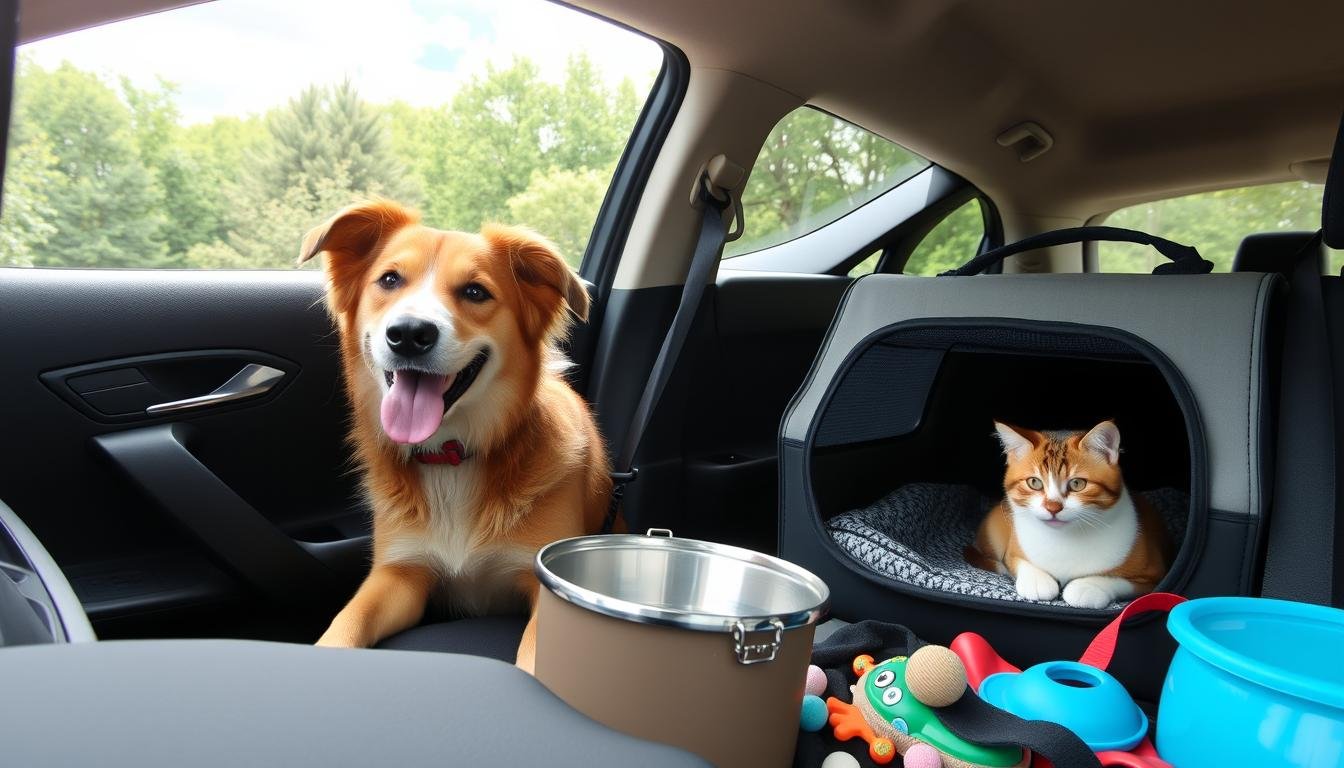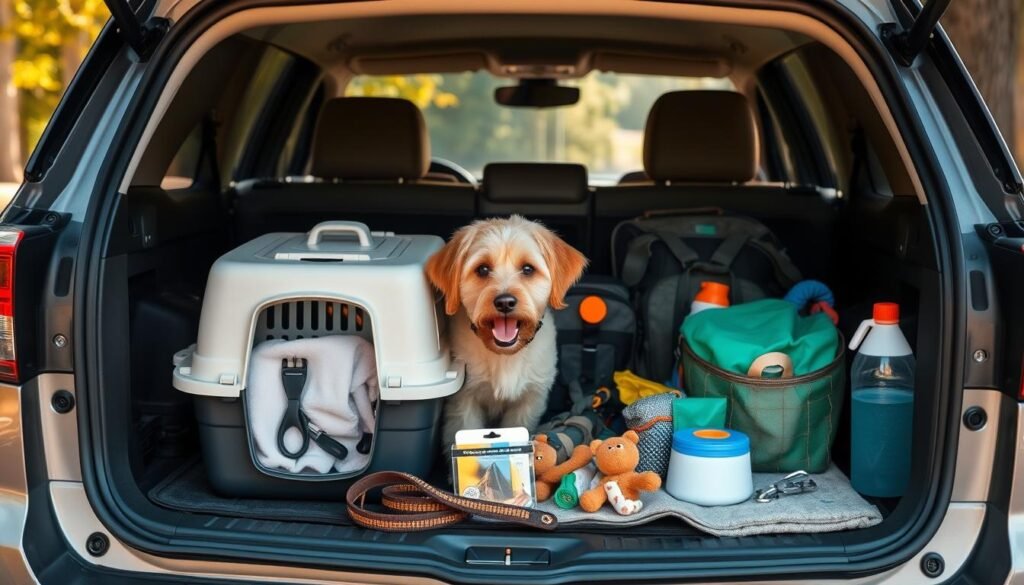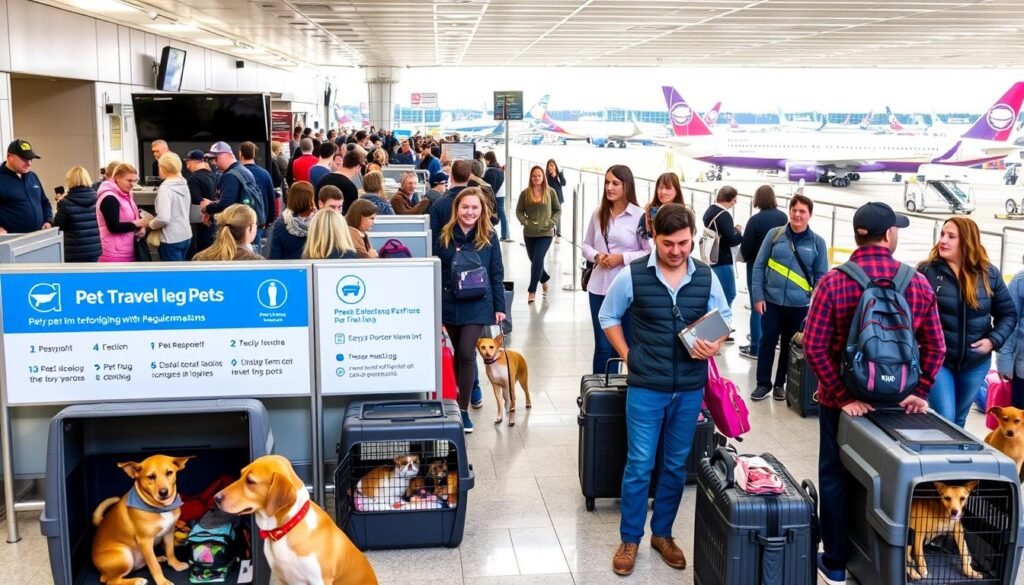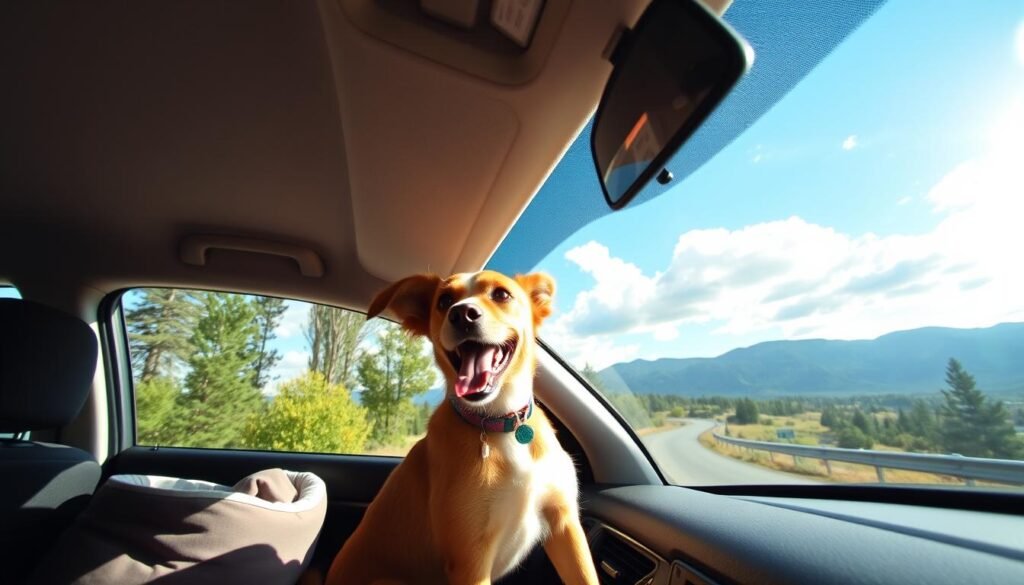Traveling with pets needs careful planning to ensure a safe and fun trip for everyone. As a pet owner who has traveled a lot with my pets, I know how important it is to be ready. In this article, I’ll share my best tips for traveling with pets. We’ll cover pet travel essentials, safety tips, and how to keep your pet comfy during the trip.
Whether you’re driving or flying, think about your pet’s needs and safety. I’ll help you pick the right gear and understand pet-friendly transportation and airline rules. By following these tips, you can make your trip stress-free and fun for both you and your pet, focusing on pet travel safety.

Key Takeaways
- Plan ahead and research pet-friendly destinations and accommodations
- Schedule a vet check-up and update your pet’s identification tags and microchip
- Choose comfortable carriers or crates and bring familiar items to reduce anxiety
- Pack essential pet supplies like food, water, medication, and a first-aid kit
- Understand airline pet policies and requirements for cabin or cargo travel
- Ensure your pet’s safety during travel with secure harnesses and frequent breaks
- Manage pet anxiety and motion sickness with natural remedies or prescribed medication
Preparing for Your Trip
Before you start your pet-friendly journey, make sure you’re well-prepared. Research, plan, and prepare to ensure a great time for both you and your pet. This way, you can enjoy exploring new places together.
Research Pet-Friendly Destinations
When picking a destination, think about what’s best for your pet. Look for places that welcome pets. Hotels, vacation rentals, and campgrounds now offer pet-friendly services. They have special areas for pets and even pet menus.
Schedule a Vet Check-Up
Get a vet check-up for your pet before you travel. This ensures they’re healthy and ready for the trip. Your vet can also give advice on keeping your pet safe and comfortable.
“I always make sure to schedule a vet check-up before traveling with my dog. It gives me peace of mind knowing that he’s in good health and ready for the adventure ahead.”
Update Identification Tags and Microchips
Travel can be exciting, but pets can get lost. Update their ID tags with your current contact info. This includes your cell phone number and any temporary addresses.
Check your pet’s microchip info too. A microchip can help find your pet if they get lost. It’s a permanent ID that reunites pets with their owners.
| Identification Method | Benefits |
|---|---|
| Updated ID Tags | Easily visible, contains current contact information |
| Microchip | Permanent, can be scanned by veterinarians and animal shelters |
By following these steps, you’re ready for a great pet-friendly trip. A bit of research and planning will make your adventure unforgettable.
Choosing the Right Pet Travel Gear
When you’re getting ready for a trip with your pet, picking the right gear is key. You’ll need everything from cozy carriers to sturdy leashes. Each item helps make your pet’s trip as stress-free as possible.

Comfortable Carriers and Crates
Getting a good carrier or crate is vital for your pet’s comfort. Think about how you’ll travel and your pet’s size. Soft carriers are great for flying, keeping your pet snug.
For bigger pets or cargo travel, choose a crate that’s sturdy and well-ventilated. This lets your pet move around comfortably.
Leashes, Harnesses, and Collars
A good leash and a fitting harness or collar are essential. Pick a leash that’s tough and can handle travel. Avoid retractable leashes, as they can be dangerous.
Make sure your harness or collar fits well without being too tight. For safer walks at night, consider a reflective or LED-lit collar or leash.
Food and Water Bowls
Keeping your pet’s eating and drinking schedule on track is important. Use collapsible bowls that are easy to clean and store. Choose bowls that are light and won’t take up too much space.
Having travel bowls makes it easy to keep your pet fed and hydrated, no matter where you are.
| Pet Travel Gear | Key Features | Benefits |
|---|---|---|
| Soft-sided Carriers | Lightweight, well-ventilated, airline-approved | Ideal for small pets traveling in airplane cabins |
| Sturdy Crates | Durable, spacious, secure | Perfect for larger pets or cargo travel |
| Leashes and Harnesses | Strong, comfortable, reflective options available | Keeps pets safe and under control in new environments |
| Collapsible Food and Water Bowls | Lightweight, easy to clean, compact | Convenient for maintaining feeding and hydration on the go |
Choosing the right pet travel gear makes your journey with your pet comfortable and fun. Quality gear ensures your pet’s safety and happiness on your travels.
Packing Pet Essentials
When you’re getting ready for a trip with your pet, it’s key to pack everything they need. Make a list of what your pet will need for the journey and at your destination.

First, pack enough food for the whole trip and a little extra. This is to cover any unexpected delays. Stick to your pet’s usual food to prevent stomach problems. Remember to include any medications in their original containers with clear instructions.
To make your pet feel more at home, bring their favorite toys, blankets, and bedding. These items can help reduce their anxiety in new places. Also, a piece of clothing with your scent can offer them extra comfort.
Other must-haves for your pet include:
- Collapsible food and water bowls
- Leash and harness
- Waste bags and a pet waste scooper
- Grooming supplies (brush, wipes, shampoo)
- Pet first aid kit
“I always make sure to pack my dog’s favorite squeaky toy and a cozy blanket whenever we travel. It helps him feel more relaxed and secure in new environments.”
Don’t forget to pack important documents for your pet. This includes vaccination records and health certificates, especially for air travel or crossing borders. A recent photo of your pet can also be useful if they get lost.
By packing all your pet’s essentials, you can make their travel experience more comfortable and stress-free for both of you.
Understanding Airline Pet Policies
Traveling with your pet by air requires knowing the airline’s pet policies. Each airline has its own rules for pet travel. It’s key to research and understand these policies before booking your flight.
Cabin vs. Cargo Travel
Decide if your pet will travel in the cabin with you or in the cargo hold. Small pets like cats and dogs can travel in the cabin with their owners. They must fit in a carrier under the seat in front of you. Larger pets or those on certain routes may need to go in the cargo hold. Always check with your airline for specific requirements.

Breed Restrictions
Some airlines restrict certain breeds, like pugs and bulldogs, due to health concerns. These breeds may face breathing issues during travel. Check with your airline for any breed restrictions that apply to your pet.
Health Certificate Requirements
Most airlines require a health certificate for pets, whether in the cabin or cargo. This certificate must be from a licensed vet and issued within 10 days of travel. It confirms your pet is healthy and up-to-date on vaccinations. Some destinations may have extra health requirements, so check well in advance.
| Airline | Cabin Travel | Cargo Travel | Breed Restrictions | Health Certificate Required |
|---|---|---|---|---|
| Delta Air Lines | Yes | Yes | Snub-nosed breeds | Within 10 days of travel |
| American Airlines | Yes | Yes | Snub-nosed breeds | Within 10 days of travel |
| United Airlines | Yes | Yes | Snub-nosed breeds | Within 10 days of travel |
Knowing airline pet policies helps ensure a smooth trip for you and your pet. This includes understanding cabin vs. cargo travel, breed restrictions, and health certificate needs.
Ensuring Pet Safety During Travel
Traveling with your pet requires careful planning to keep them safe and comfortable. By taking the right steps, you can make the journey enjoyable for both of you. Here are some important things to remember:
Securing Your Pet in the Vehicle
Keeping your pet safe in the car is crucial. Use a carrier, crate, or pet seatbelt to keep them in place. This not only protects them but also keeps them from distracting the driver.

Choose a carrier or crate that fits your pet well. It should let them stand, turn, and lie down easily. Use a seatbelt or strong restraints to keep it in place while driving.
Frequent Breaks for Exercise and Potty Time
Long trips need regular breaks for your pet to exercise and go to the bathroom. Look for pet-friendly stops, parks, or areas along your route. These breaks help keep your pet happy and healthy.
“I always make sure to schedule plenty of breaks when traveling with my dog. It helps keep him happy and reduces the risk of accidents in the car.” – Sarah, experienced pet traveler
Keep your pet on a leash during these breaks. This ensures their safety and prevents them from getting lost.
Maintaining a Comfortable Temperature
Extreme temperatures can harm your pet during travel. It’s vital to keep them comfortable, whether by car or plane.
In a car, make sure the AC or heating works well. Adjust it to keep your pet comfortable. Never leave them alone in a parked car, as it can get too hot or cold.
- If flying, pick times that avoid extreme weather.
- Make sure your pet’s carrier has good airflow.
- Keep your pet hydrated with fresh water during the trip.
By following these tips, you can make travel safe and enjoyable for your pet. This way, you both can have a great time together.
Managing Pet Anxiety and Motion Sickness
Traveling with pets can be a wonderful experience. But, it’s important to think about their well-being during the trip. Many pets get anxious or sick from motion, which can stress them and their owners. Luckily, there are ways to ease these issues and make the trip better for your pet.
Using natural calming aids like pheromone sprays or collars can help with pet anxiety. These products mimic the calming pheromones that mother dogs produce. If your pet’s anxiety is severe, talk to your vet about prescription medications that can help them relax during travel.

For pets that get motion sickness, your vet might suggest anti-nausea medication. It’s also wise to feed your pet a light meal a few hours before traveling. This can help prevent an upset stomach. Make sure your pet has a comfortable and secure place to sit during the journey, like a well-ventilated carrier or crate.
“I always make sure to give my dog his favorite toy and a cozy blanket in his crate when we travel. It helps him feel more at ease and reduces his anxiety.”
Getting your pet used to their carrier or crate before the trip is key. Start by placing their carrier in a familiar room with the door open. Encourage them to explore it with treats and praise. Gradually increase the time they spend inside, and take short car rides to help them get used to the motion. These steps can make your pet feel more comfortable and confident during travel.
In summary, managing pet anxiety and motion sickness involves several strategies:
- Using natural calming aids or prescription anti-anxiety medications
- Providing anti-nausea medication and feeding a light meal before travel
- Offering a comfortable and secure space for your pet during the journey
- Acclimatizing your pet to their carrier or crate before the trip
By following these steps, you can ensure your pet stays happy, healthy, and comfortable on your travels together.
Tips for Traveling with Pets on Road Trips
Planning a road trip with your pet requires some preparation. This ensures a fun trip for both you and your pet. By considering your pet’s needs, you can make lasting memories on your journey.
Planning Pet-Friendly Routes
Choosing a pet-friendly route is key. Look up rest stops, parks, and attractions that allow pets. Websites and apps can help find these places, making your trip planning easier.

- Ample green spaces for your pet to stretch their legs and relieve themselves
- Safe, secure areas for your pet to explore and play
- Access to fresh water and shade, especially during warmer months
- Proximity to pet-friendly accommodations for overnight stays
Packing a Pet First Aid Kit
Just like you, your pet needs a first aid kit. A well-stocked kit can help with minor emergencies. Include items like bandages, antiseptic wipes, and your pet’s medications.
| Item | Purpose |
|---|---|
| Bandages and gauze | To cover and protect wounds |
| Antiseptic wipes or solution | To clean and disinfect minor cuts or scrapes |
| Tweezers | To remove splinters, ticks, or debris from your pet’s skin or fur |
| Scissors | To trim fur around wounds or cut bandages to size |
| Disposable gloves | To maintain hygiene while administering first aid |
| Your pet’s medications | To ensure a consistent supply of any necessary treatments |
Learn how to use your pet first aid kit before you go. Also, save vet clinic numbers for emergencies.
Maintaining a Consistent Routine
Pets like routine, which helps reduce stress on trips. Stick to their regular schedules for feeding, potty breaks, and exercise. Adjust their routine a few days before traveling to help them adjust to new time zones.
Bringing along familiar items from home, such as your pet’s favorite bedding, toys, and food and water bowls, can provide a comforting presence in unfamiliar surroundings.
By focusing on your pet’s needs and keeping a routine, you’ll make your road trip more enjoyable for both of you.
Navigating Pet-Friendly Accommodations
Traveling with your pet requires finding the right place to stay. This ensures a comfortable trip for you and your pet. With some research and planning, you can find the perfect spot.
Start by researching hotel pet policies. Hotels have rules about pet size, breed, and number per room. They also charge extra fees or deposits for pets. Knowing these rules helps avoid surprises during your stay.
Finding Pet-Friendly Vacation Rentals
For a homey feel or more space, look into pet-friendly vacation rentals. Sites like Airbnb and Vrbo let you search for pet-friendly places. These rentals offer comforts like private yards and pet beds.
Whether it’s a hotel or rental, tell the provider you’re bringing a pet. Even if it’s pet-friendly, letting them know in advance is polite. It also helps you find out about pet amenities and attractions nearby.
FAQ
What are the most important things to consider when traveling with my pet?
When traveling with your pet, look for places that welcome pets. Check out pet-friendly hotels and transportation. Make sure your pet is healthy and has all the necessary supplies.
Don’t forget to update your pet’s ID tags and microchip info before you go.
How do I choose the right pet carrier for travel?
Choose a carrier that fits your pet and your travel method. Soft carriers work for flying, while sturdy crates are better for cars or cargo. Make sure it’s comfy, well-ventilated, and secure for your pet.
What should I pack in my pet’s travel kit?
Your pet’s kit should have food, water, bowls, and a leash. Include ID tags, waste bags, and any meds they need. Remember to pack vaccination records and a recent photo of your pet.
Don’t forget their favorite toys, blankets, and bedding for comfort.
How do I ensure my pet’s safety during car travel?
Use a carrier, crate, or harness to keep your pet safe in the car. Plan breaks for exercise and potty time. Keep the car at a comfortable temperature and never leave your pet alone.
What should I know about airline pet policies?
Each airline has its own pet policy. Some allow pets in the cabin, while others require the cargo hold. Know about breed restrictions, health certificates, and any extra fees.
Book early and choose a flight that avoids extreme weather.
How can I help my pet cope with anxiety or motion sickness during travel?
For anxiety or motion sickness, try natural calming aids or ask your vet about meds. Get your pet used to their carrier before the trip. For motion sickness, your vet might suggest anti-nausea meds or a light meal before traveling.
What should I look for when booking pet-friendly accommodations?
When booking, check the hotel’s pet policy for size, breed, and number limits. Look for any extra fees or deposits. Consider vacation rentals or bed and breakfasts that welcome pets.
Always tell the accommodation provider you’re bringing a pet to ensure they’re ready for you.
How do I maintain my pet’s routine during travel?
Try to keep your pet’s regular schedule for feeding, potty breaks, and exercise. Bring familiar items like bedding and toys. Plan your trip to include pet-friendly stops for breaks and exercise.


